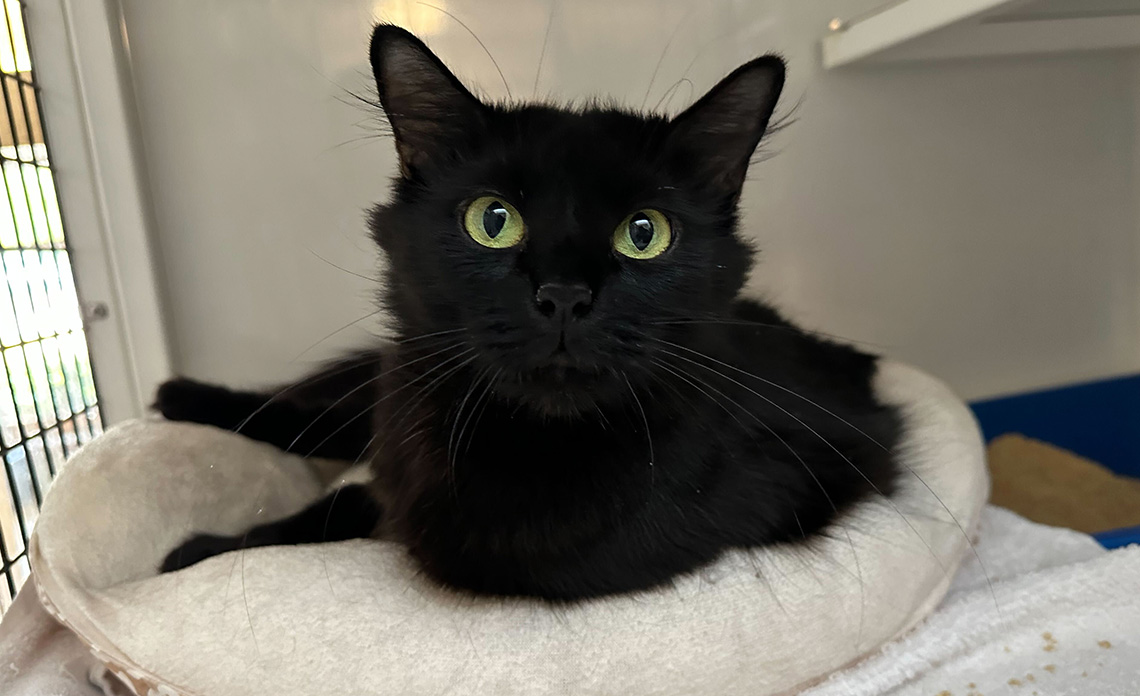This blog post is written by volunteer Tracy Begland.
The seven-year-old dark brown and black striped male cat with a rear-pelvic fracture had no chance of evading the Dallas animal control officer. He resorted to using what he still could: his teeth. With emerald-green eyes that dominate his narrow face, Mac was an animal many shelters would deem unadoptable. In what may have been the first lucky break of his life, Dallas County transferred the skinny feline to Operation Kindness. The interventions of veterinarians, behaviorists and volunteers over his four-month stay transformed Mac’s life in unimaginable ways.
Arriving at Operation Kindness
Mac’s journey is nothing new for the iconic North Texas animal welfare organization that grew from nine animal lovers in a Garland storefront in 1976 to a staff of over 140, an army of volunteers, and a 9,900-square-foot facility with a dedicated medical wing. Just last year, the shelter donated nearly 150,000 pounds of pet food to owners in need and found homes for more than 4,500 homeless dogs and cats. The non-profit receives no government funding yet assists more than one hundred municipal shelters and rescue groups across Texas. Not every animal needs all the shelter’s resources. The average shelter stay for felines is five and a half days. But for animals like Mac, these resources were vital.
“Mac was very standoffish and under-socialized,” according to Angelica Olmos, a behaviorist at the shelter. “You couldn’t approach his kennel. You couldn’t pet him. He wouldn’t take treats from you.” Once the medical team discharged him, the behaviorists took over. “Mac was on bed rest, so we had to redo our training plan. We couldn’t do free roaming. We couldn’t do cat patio time. We couldn’t do the things we would normally do for our under-socialized cats,” Angelica said. “[Instead] we put him on Cat Pawsitive.”
A Cat Pawsitive Experience
The Cat Pawsitive program was developed by “cat whisper,” Jackson Galaxy. Using clicker training and positive reinforcers, shelter cats become comfortable with human eye contact and touch. They begin to approach the front of their kennels, increasing their chances of adoption, instead of hiding in the back corner. The program increases socialization as cats learn to nose bump targets and high-five humans. Shelter animals gain a sense of control in an environment where they have no control. “Cats especially like consent, [so we] feed off of that,” Angelica said. “‘You don’t want to be touched right now. That’s fine. I’m going to give you a treat or toy just so that there is that association.’ Then we’ll try again later. [We] build on those positive experiences until they learn that this is not a threatening thing.”
I first met Mac when I started volunteering at Operation Kindness. He watched me warily when I opened the door to his enclosure. I talked softly to him and offered him treats. He did not move from his cat bed. Over the next few weeks as the behaviorists and trained volunteers used Cat Pawsitive to overcome Mac’s trust issues, I observed changes in his behavior. When I opened his kennel door, he moved toward me. He dipped his chin and allowed me to stroke his head. One day Mac surprised me. He rose from his cat bed, rushed toward the door, and rolled onto his back. He demanded a lengthy belly rub as he kneaded his front paws and purred. By the time I had returned for my next volunteer shift, Mac had left the shelter for his new family.
This month seventy-two North Texas animal shelters are participating in the “Clear the Shelters” program. If you have room in your home and heart for an animal, I encourage you to visit Operation Kindness or any animal shelter. My favorite days at the shelter are when adopters come in and say that they want the oldest cat, a special needs dog, or the animal that has been in the shelter the longest. Today you might find your own “Mac.” A polite feline ready to give his human a high five.
Stay up to date
Follow us on Facebook, Instagram and Twitter for the latest news.





